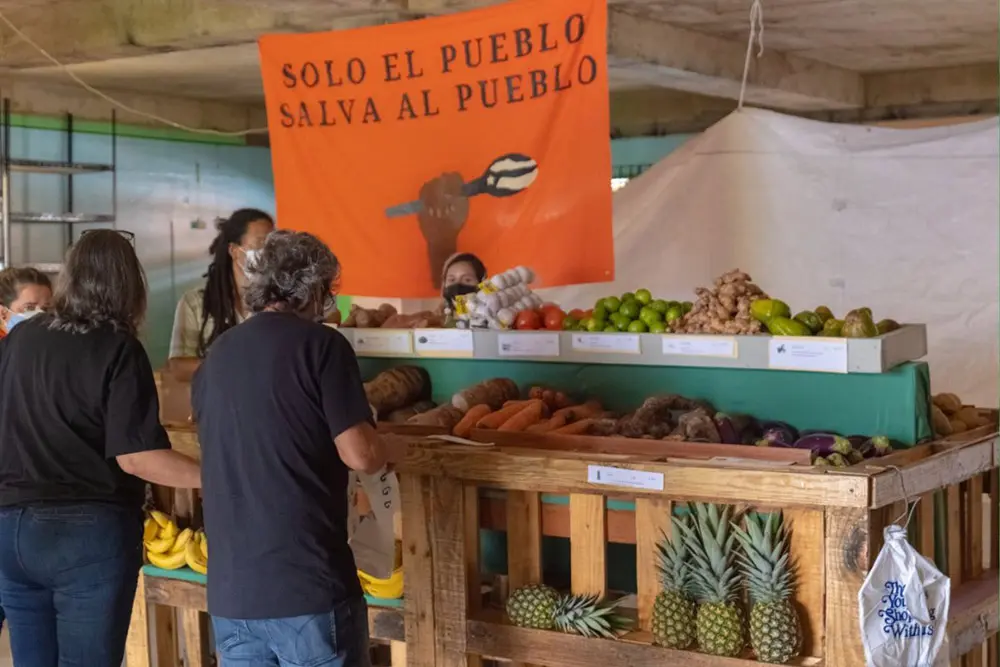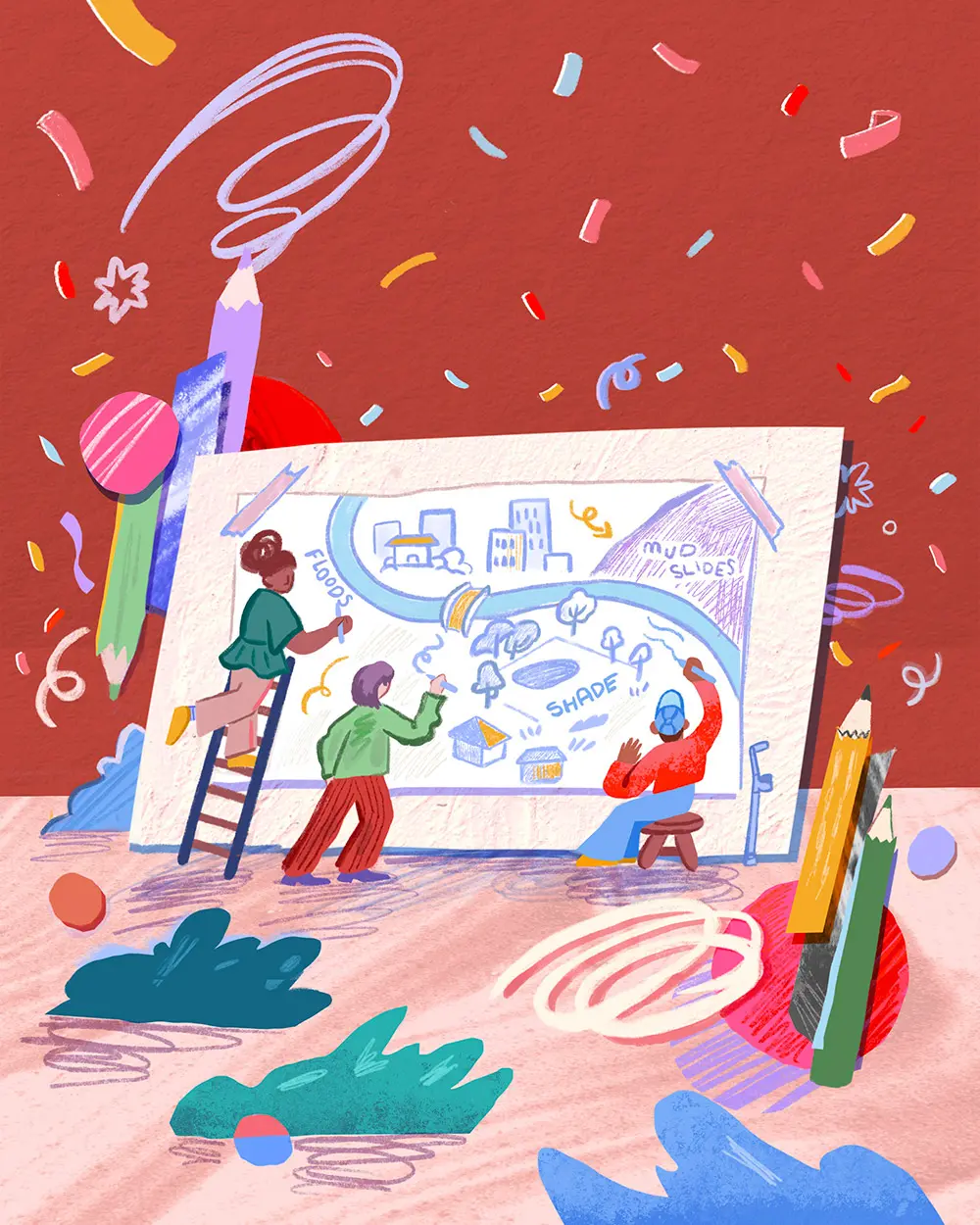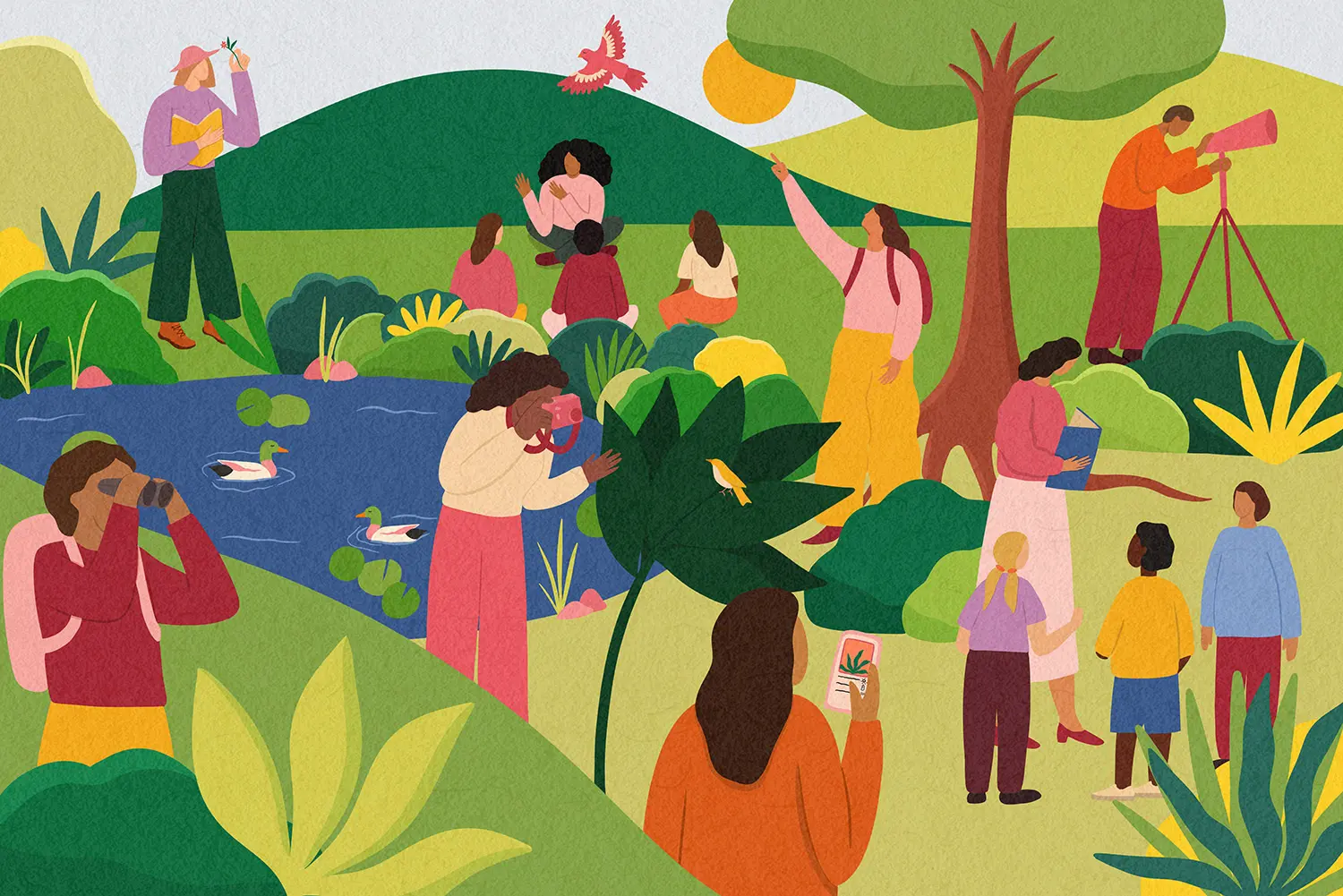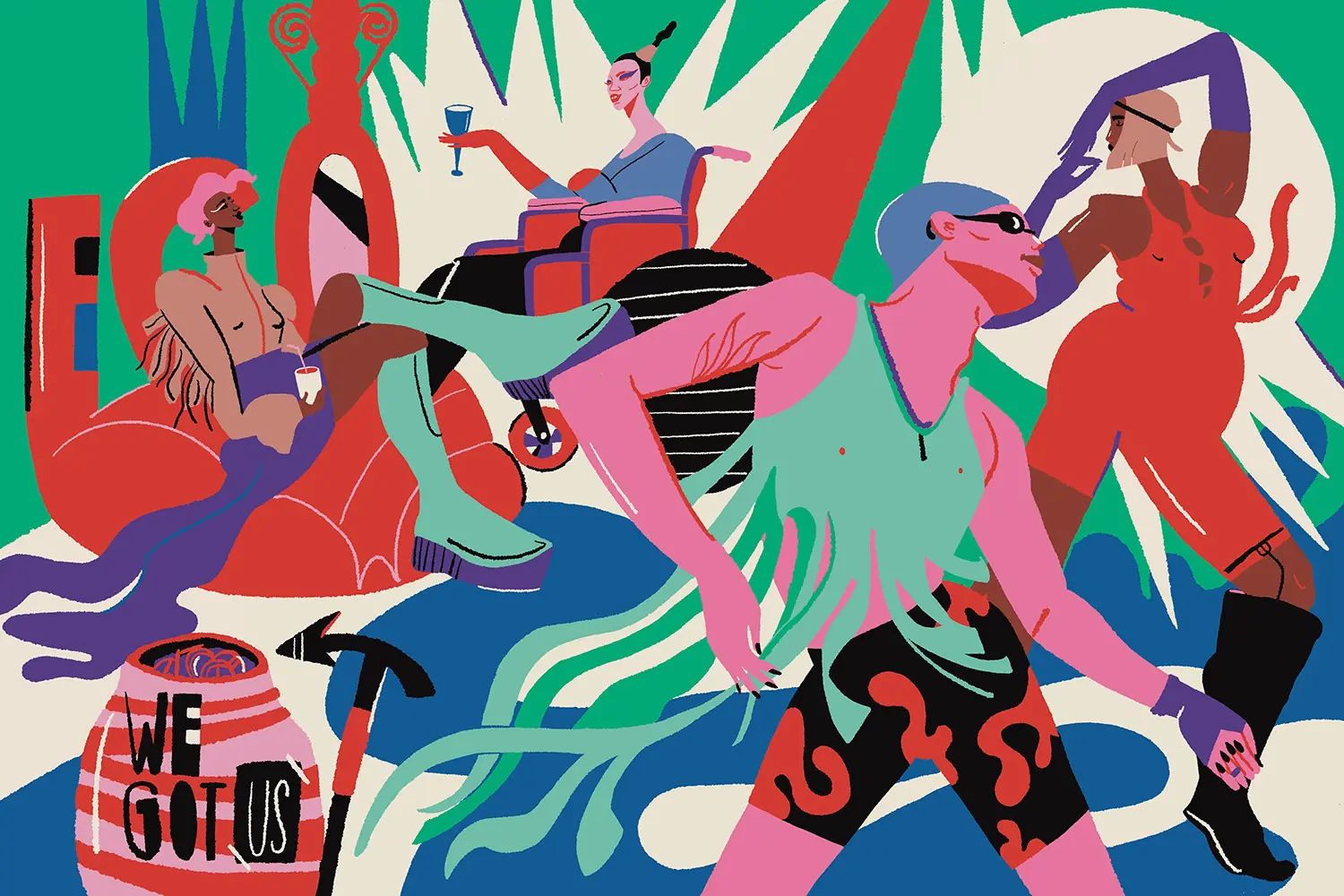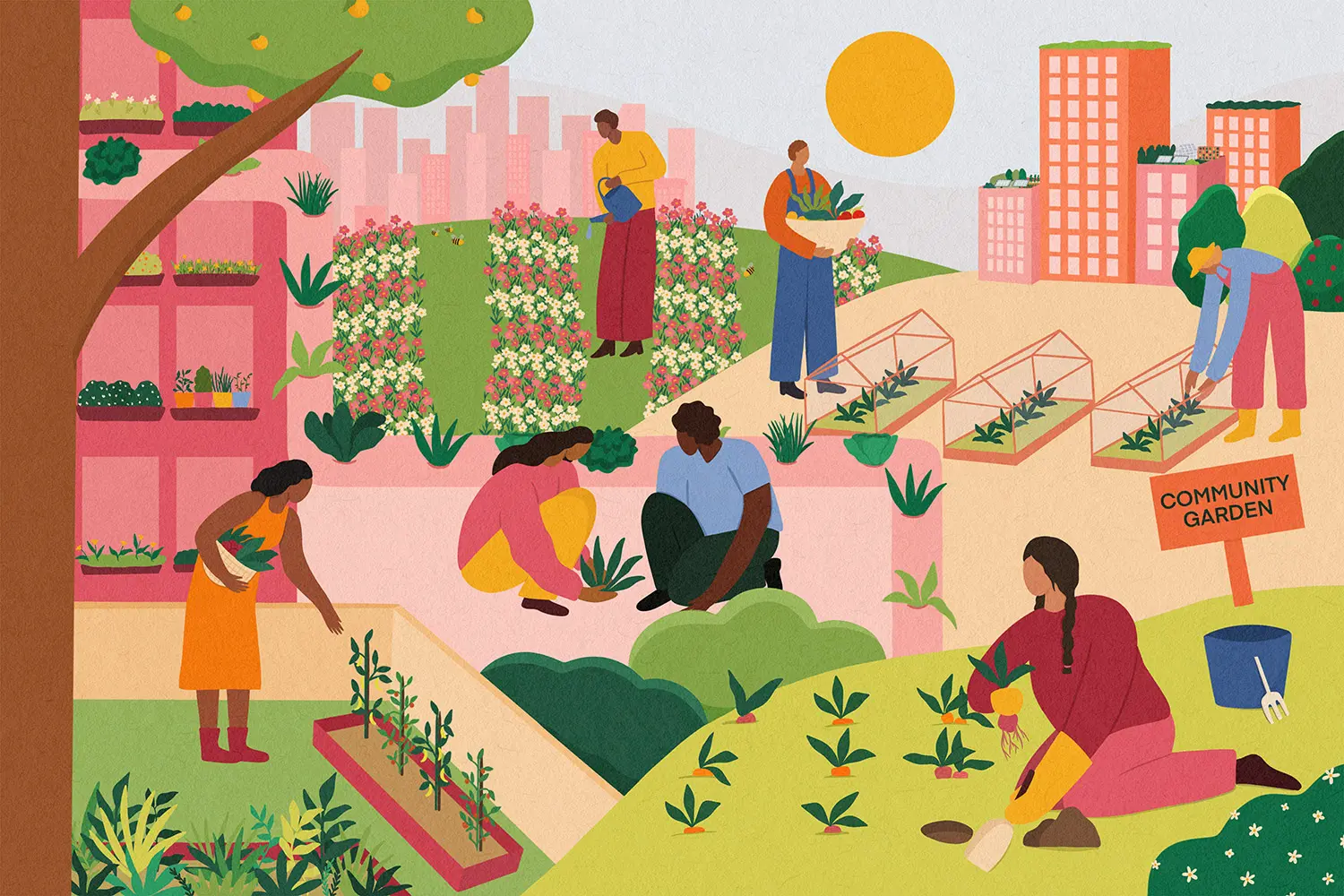Climate resilience as Disaster Collectivism
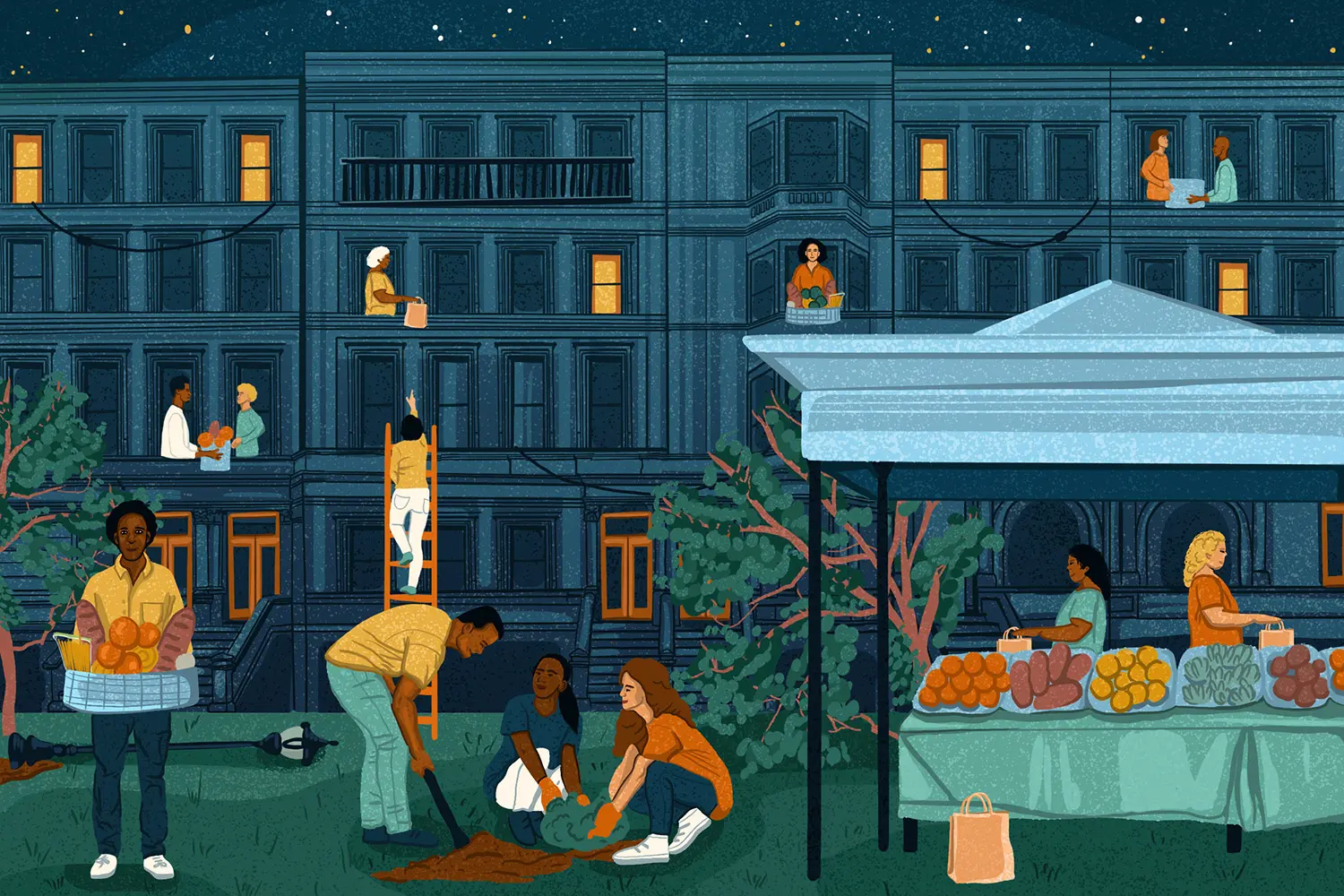
What it is: Disaster collectivism, a phenomenon coined by author and historian Rebecca Solnit in her 2009 book A Paradise Built in Hell, is described as “the sense of immersion in the moment and solidarity with others caused by the rupture in everyday life” during and following a crisis. It refers to the increased cooperation, mutual aid, and collective action that often emerges during times of disaster.
Disaster collectivism may look like:
- Neighbors self-organizing to help meet one another’s immediate needs, transforming community gathering spaces into makeshift communal kitchens, shelters, information hubs, medical and childcare centers, backup energy sources, etc.
- Mutual aid networks popping up to help redistribute financial resources, food, water, and other supplies and forms of support with one another
- Neighbors rallying together to clean up and rebuild homes and community spaces
- People providing one another with emotional and psychological support and co-regulating, grieving, and healing with eachother
- Neighbors strategizing and organizing with one another to access emergency response resources, influence local and regional policy and planning decisions, and help address the roots of the crisis and the vulnerabilities that exacerbated the situation
And so on.
Some additional context: After analyzing decades of major calamities, like the 1906 earthquake in San Francisco, a 1917 cargo ship explosion in Halifax, and the aftermath of Hurricane Katrina in 2005, Rebecca Solnit found that, time and time again, neighbors turned to one another to meet collective needs and build new structures of care and support. She challenges the prevailing notion that disasters lead to chaos and violence. Instead, in a deeply optimistic portrayal of humanity, she suggests that people are at their most altruistic and caring in the wake of crisis, and that while disasters are tragic, the collapse of normality can allow for new forms of civic engagement and public life to take root.
Continue readingIt’s a myth that our reactions to danger are fight or flight. There’s a third option often pursued: to gather for reassurance, protection, strength, and insight. Rebecca Solnit, writer, historian, and activist (source)
Why it’s a climate resilience powerhouse:
Meeting community needs and caring for one another during and after crisis:
In situations where the formal emergency management system falls short (which is often), disaster collectivism can help fill the gaps in meeting the immediate and long-term needs of affected individuals and communities. Through disaster collectivism strategies like self-organizing, developing mutual aid networks, and tapping into community assets, community members can provide one another with the vital resources, support, and assistance that may not be adequately provided by formal systems. Given the state of the emergency management system in the so-called United States, this filling-in-the-gaps work is imperative.
Disaster collectivism strategies can also help to address the deep inequities in disaster relief provided through more formal emergency management system channels. Samantha Montano explains in her 2021 book Disasterology that the American emergency management system is predicated upon a limited intervention model; the government intentionally limits the help that they give with the expectation that individuals should pay for their own recovery using their savings and insurance payouts from the private sector. This model upholds an individual approach to recovery, despite the fact that recovery is a complex communal process far beyond individual control. It also upholds white elitism. Montano elaborates that emergency aid is typically delivered along racial and class lines, while those most impacted—communities of color and low-income communities—are generally left dependent on nonprofits and the fickle attention of national media to receive help (for more insight into the inequities in disaster relief, this NY Times article, this Scientific American article, and this Axios article are great places to start). Disaster collectivism strategies, meanwhile, can center the folks who are most excluded from formal aid systems, therefore ensuring that everyone receives the support and resources they need.
Disaster collectivism strategies also allow for immediate action and a quicker response than formal emergency management systems can provide in the aftermath of disaster. While official response systems may take time to mobilize and coordinate, community members are already on the ground. Grassroots efforts can provide speedy support with time-sensitive matters such as search and rescue operations, emergency supply distribution, ad hoc shelters, kitchens, and medical centers, and other forms of community care.
Finally, disaster collectivism strategies tap into invaluable local knowledge, networks, and resources. When community members themselves are leading response and recovery efforts, they are equipped with local expertise, connections, and deep cultural understanding that organizations parachuting in inherently lack.
There are countless examples of disaster collectivism in action working to meet the needs of community members during and after crisis. Among them:
- The Rockaway Youth Task Force + Hurricane Sandy: When Hurricane Sandy made landfall in the Rockaway peninsula in Queens, New York in the fall of 2012, a youth-led task force, which was actually less than a year old, was poised and ready to spring into action. The youth volunteer brigade, which was about 50-members strong, immediately mobilized its members to conduct door-to-door outreach to identify and assist vulnerable individuals and distribute emergency supplies to residents in need. The Rockaway Youth Task Force organized clean-up efforts, helping to clear debris, mud, and damaged materials from homes and streets. They also established community resource centers that served as hubs for information, assistance, and coordination with other organizations and volunteers. These centers provided residents with access to vital resources, including information on disaster recovery programs, housing support, and mental health services.
Mask Oakland + Northern California Wildfires: During the fall of 2017, wildfire smoke was so intense across California’s Bay Area that it wasn’t considered safe to be outside, and protective N95 masks were selling out fast. A queer, disabled activist realized that the folks who needed protective equipment the most, such as unhoused folks (who are disproportionately queer and/or disabled), would likely have the least access, and so they tracked down a bunch of masks, created accounts on Twitter and Venmo to raise money to buy more, and started handing them out. Mask Oakland has since evolved into an ongoing mutual aid effort responsible for distributing tens of thousands of masks and other protective gear to folks who need it most during the height of wildfire seasons in the Bay Area.
Continue readingGetting organized and resisting disaster capitalism
Disaster collectivism is perhaps the most effective antidote disaster capitalism, a sinister phenomenon labelled by author Naomi Klein in her 2007 book The Shock Doctrine: The Rise of Disaster Capitalism, which refers to the way that private corporations and policy makers exploit political, economic, and ecological crises to strengthen their own interests, consolidate control, and erode public infrastructure. Klein illuminates a pernicious pattern: after a shock occurs, communities are disoriented and distracted, democratic norms are suspended in the name of addressing the crisis at hand, and politicians ram through a corporate wish list as quickly as possible under the guise of recovery. The policies implemented often involve deregulation, austerity measures, and privatization, and usually benefit a select few at the expense of the majority.
Continue readingPart of the crisis is the way we are responding to the crisis. Bayo Akomalafe, poet and philosopher
However, when people respond to crisis by sharing resources, cultivating lasting connections, and organizing, it’s possible to both resist disaster capitalism policies and programs and propel people-powered movements forward. Many disaster collectivism efforts result in communities that are permanently organized (read more about the idea of “permanently organized communities” in this Movement Generation article and this follow-up article in Shareable), who have established the relationships, social infrastructure, and organizing muscles to rapidly mobilize and care for one another through both the slow, simmering stressors and major shocks to come.
For instance:
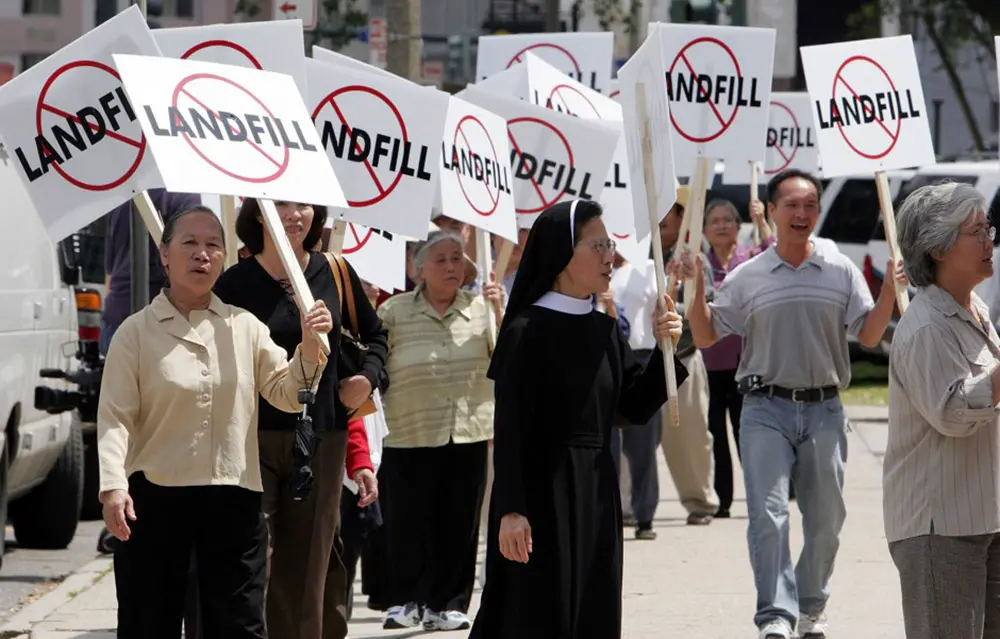 Village de L’Est + Hurricane Katrina: After residents of Village de L’Est returned to their neighborhood in the wake of Hurricane Katrina’s destruction, it was announced that a 100-acre landfill known as Chef Menteur Landfill would be built nearby to take in a portion of the city’s smashed homes and toxic hurricane debris—without even conducting an environmental impact study or holding a public hearing (which was only possible due to the emergency powers granted to the mayor in the wake of a major hurricane). Fortunately, the Village de L’Est community was already relatively tightknit and organized, helping one another to rebuild their homes and community spaces. When they heard the news, a coalition of community members, environmentalists, social justice advocates, and elected officials banded together to hold meetings, protest, organize rallies, garner media attention, and wage legal battles at the state and federal level. Their efforts were successful, and the Chef Menteur Landfill was eventually closed. Plus, ongoing grassroots initiatives and people-powered movements emerged from this moment; groups like VAYLA are still active in New Orleans East today!
Village de L’Est + Hurricane Katrina: After residents of Village de L’Est returned to their neighborhood in the wake of Hurricane Katrina’s destruction, it was announced that a 100-acre landfill known as Chef Menteur Landfill would be built nearby to take in a portion of the city’s smashed homes and toxic hurricane debris—without even conducting an environmental impact study or holding a public hearing (which was only possible due to the emergency powers granted to the mayor in the wake of a major hurricane). Fortunately, the Village de L’Est community was already relatively tightknit and organized, helping one another to rebuild their homes and community spaces. When they heard the news, a coalition of community members, environmentalists, social justice advocates, and elected officials banded together to hold meetings, protest, organize rallies, garner media attention, and wage legal battles at the state and federal level. Their efforts were successful, and the Chef Menteur Landfill was eventually closed. Plus, ongoing grassroots initiatives and people-powered movements emerged from this moment; groups like VAYLA are still active in New Orleans East today! - Undocufund + The Tubbs Fire: The Undocufund for Disaster Relief emerged in 2017 after the Tubbs Fire tore through Napa and Sonoma Counties, incinerating dozens of city blocks, displacing thousands of people, and putting countless jobs in jeopardy. The folks at Graton Day Labor Center, North Bay Organizing Project, and North Bay Jobs with Justice knew that the region’s undocumented residents would have the least access to resources and services to recover in the wake of the fire, so they leapt into gear to establish a fund that undocumented families would be able to tap into. Not only was Undocufund able to redistribute resources to thousands of families, but it became a vehicle for organizing as a means to address labor and environmental justice issues. As one of Undocufund’s co-founders, Mara Ventura, shared in Climate Resilience, “We knew that the Tubbs Fire was an open invitation for disaster capitalism and low-road contractors to come into Sonoma County, and we felt an intense urgency to start organizing people immediately. We were able to mobilize actions from our local supervisors all the way up to the governor of California to kick low-road contractors out of Sonoma County and ensure that union workers were able to do the important work and that there were also pathways for folks who were undocumented or immigrant workers to access these jobs safely and fairly.” Undocufund has been fundraising, redistributing resources, and organizing folks in moments of crisis, such as subsequent wildfire seasons and the Covid-19 pandemic, ever since.
The nuance / caveats:
The post-disaster camaraderie and solidarity that Rebecca Solnit writes about is not a given. During the Covid-19 pandemic, for instance, mutual aid networks proliferated, but there was also widespread resistance toward acts of collective care that would help keep fellow community members safe, like mask wearing, social distancing, and getting vaccinated. Communities must consciously commit to the collective good amid crisis, or else it’s very possible that the quintessential American value of individualism will win out. Communities are much likelier to band together if they have been exercising collectivism muscles and cultivating relationships, trust, and mutual respect long before disaster strikes.
It’s also important to note that many communities that have cultivated tremendous mutualism in the wake of disaster, like post-Hurricane-Maria Puerto Rico and post-Hurricane-Katrina New Orleans, have still suffered the consequences of disaster capitalism and atrocious emergency management responses. Disaster collectivism provides a framework and strategies for more equitable and sustainable recovery efforts, and it isn’t a silver bullet solution to all the problems associated with disasters. As Samantha Montano explains in Disasterology, true disaster justice will require a complete upending of the emergency management system as we know it.
Continue readingResearch + reflection prompts:
- Make a list of communities or networks you’re a part of that you could help mobilize, communicate with, and/or receive support from during or after a crisis.
How to get engaged:
Meet your neighbors
If you don’t already know your neighbors: Get to know them. Depending on where you live and what makes sense for you, this could look like organizing a potluck or block party or simply knocking on neighbors’ doors and introducing yourself (perhaps with baked goods or garden goodies in tow). Once you’ve developed some rapport and trust with neighbors, you can strategize more specifically about how you can start preparing for possible disasters together. A wonderful place to start is by making and distributing a list of names, contact information, specific needs during potential emergencies (e.g., neighbor #1 can’t drive and will need a ride, neighbor #2 uses a respirator and will need access to a backup power supply if the grid is shut off, etc.), and community assets that might support your community during a crisis (e.g., backup generators, spare fridges, freezers, or root cellars, food and herb gardens, etc.).
Bring folks together
If you love weaving and nourishing community: Consider how you (and other pals) might bring folks together on a regular basis around a shared identity (e.g., QTBIPOC folks or new parents) or interest (e.g., a hobby, sports team, book genre, or area of activism) to experience camaraderie, joy, physical and spiritual nourishment, and sense of safety. There are countless examples of folks cultivating powerful communities through regular soup nights, dance parties, open mics, and game nights, whether at a local bookstore, bar, café, neighborhood park, or a friend’s spacious living room. The key is to bring together folks who might not already know one another, so attendees have the opportunity to expand their social networks. In moments of crisis, you can then utilize your event listservs, social media platforms, and group texts to check in on one another and coordinate support in preparedness, relief, and recovery efforts.
Use your platform
If you have access to a platform: Use it to demand an equitable, just, and effective emergency management response and to amplify stories and action items during and after a disaster (and especially the disasters that aren’t garnering as much mainstream attention). Samantha Montano writes in Disasterology, “The media is one of the most important participants in emergency management. Survivors depend on it for information about the disaster itself; if they need to evacuate, how to stay safe, where to find shelter or food … Those outside the disaster depend on media to tell us what is happening, if our family and friends are safe, and how we can help. Furthermore, the media is supposed to hold emergency management accountable. When help doesn’t arrive and government officials fail to respond effectively, it is the responsibility of the media to illuminate their failures. Accurate, appropriate, and timely disaster coverage literally saves lives.” Whether you’re a journalist, run a large social media account, or have a newsletter, blog, or podcast, remember that it can be an effective tool in disseminating timely information, raising funds, and holding government and nonprofit entities accountable.
Call or write
If you have a few minutes: Call or write your elected officials and the federal administration and ask them to consider removing the Federal Emergency Management Agency (FEMA) from the Department of Homeland Security (DHS) (and reach out to a few pals to do the same!). Samantha Montano explains in Disasterology that demoting FEMA to become one agency among many within the DHS resulted in FEMA becoming “a shell of an agency with a meager and insufficient budget, perpetual understaffing, and minimal authority.” While every aspect of the federal emergency management system in the so-called United States requires a real reckoning in order to be effective and just, disentangling FEMA from DHS is a good place to start.
Nurture disaster collectivism
Explore mutual aid and community gathering spaces for more ways to help nurture disaster collectivism in your community!
A smattering of resources for continued learning + action:
Short Reads
- “The Key to Disaster Survival? Friends and Neighbors” by Shankar Vedantam in NPR
- “Disaster collectivism: How communities rise together to respond to crises” by Robert Raymond in Shareable
- ★ “How to Survive a Disaster” by Rebecca Solnit in Literary Hub
- “I study collapsed civilizations. Here’s my advice for a climate change apocalypse” by Chris Begley in the Lexington Herald Leader
- “Puerto Ricans and Ultrarich “Puertopians” Are Locked in a Pitched Struggle Over How to Remake the Island” by Naomi Klein and Lauren Feeney in The Intercept
Guides & Reports
Long Reads
- A Paradise Built in Hell: The Extraordinary Communities That Arise in Disaster by Rebecca Solnit
- ★ The Battle for Paradise: Puerto Rico Takes on the Disaster Capitalists by Naomi Klein
- The Shock Doctrine: The Rise of Disaster Capitalism by Naomi Klein
- No Is Not Enough: Resisting the New Shock Politics and Winning the World We Need by Naomi Klein
- ★ Disasterology: Dispatches from the Frontlines of the Climate Crisis by Samantha Montano
- Aftershocks of Disaster: Puerto Rico Before and After the Storm edited by Yarimar Bonilla and Marisol LeBrón
- Parable of the Sower by Octavia Butler
Watch
- ★ Why community is our best change for survival: a 17-minute TED talk by Christine Nieves about the power of community in post-Hurricane Maria Puerto Rico
- The Battle for Paradise: Naomi Klein Reports from Puerto Rico: 17-minute of coverage produced by The Intercept following Naomi Klein exploring the impacts of both disaster capitalism and collectivism in post-Hurricane Maria Puerto Rico
- Building Collective Resilience in the Wake of Disasters: a 12-minute TED talk by Tom Llewellyn about the power of disaster collectivism
- The Response: How Puerto Ricans Are Restoring Power to the People: a 30-minute film about the mutual aid centers that proliferated across Puerto Rico after Hurricane Maria
- Aftershocks of Disaster: a 30-minute film by Juan Carlos Dávila and Yarimara Bonilla based on the homonymous book
